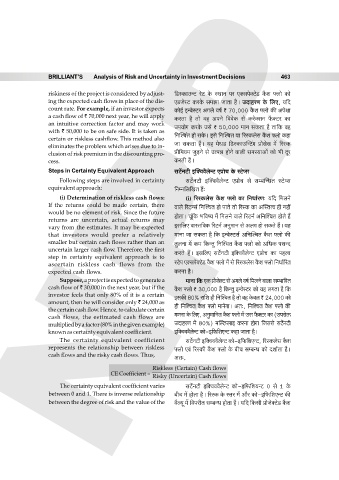Page 463 - Corporate Finance PDF Final new link
P. 463
NPP
BRILLIANT’S Analysis of Risk and Uncertainty in Investment Decisions 463
riskiness of the project is considered by adjust- {S>ñH$mCÝQ> aoQ> Ho$ ñWmZ na EŠgnoŠQ>oS> H¡$e âbmo H$mo
ing the expected cash flows in place of the dis- ES>OoñQ> H$aHo$ g_Pm OmVm h¡Ÿ& CXmhaU Ho$ {bE, `{X
count rate. For example, if an investor expects H$moB© BÝdoñQ>a AJbo df© ` 70,000 H¡$e âbmo H$s Anojm
a cash flow of ` 70,000 next year, he will apply H$aVm h¡ Vmo dh AnZo {ddoH$ go H$aoŠeZ \¡$ŠQ>a H$m
an intuitive correction factor and may work Cn`moJ H$aHo$ Cgo ` 50,000 _mZ gH$Vm h¡ Vm{H$ dh
with ` 50,000 to be on safe side. It is taken as
{ZpíM¨V hmo gHo$Ÿ& Bgo {ZpíMV `m [añH$bog H¡$e âbmo H$hm
certain or riskless cashflow. This method also
eliminates the problem which arises due to in- Om gH$Vm h¡Ÿ& `h _oWS> {S>ñH$mCpÝQ>¨J àmogog _| [añH$
àr{_`_ Ow‹S>Zo go CËnÞ hmoZo dmbr g_ñ`mAm| H$mo ^r Xya
clusion of risk premium in the discounting pro-
cess. H$aVr h¡Ÿ&
Steps in Certainty Equivalent Approach gQ>}ZQ>r BpŠdd¡boÝQ> EàmoM Ho$ ñQ>oßg
Following steps are involved in certainty gQ>}ZQ>r BpŠdd¡boÝQ> EàmoM go gå~pÝYV ñQ>oßg
equivalent approach: {ZåZ{b{IV h¢…
(i) Determination of riskless cash flows: (i) [añH$bog H¡$e âbmo H$m {ZYm©aU… `{X {_bZo
If the returns could be made certain, there dmbo [aQ>Ýg© {ZpíMV hmo nmVo Vmo [añH$ H$m ApñVËd hr Zht
would be no element of risk. Since the future hmoVmŸ& My§{H$ ^{dî` _| {_bZo dmbo [aQ>Z© A{ZpíMV hmoVo h¢
returns are uncertain, actual returns may
vary from the estimates. It may be expected Bg{bE dmñV{dH$ [aQ>Z© AZw_mZ go AbJ hmo gH$Vo h¢Ÿ& `h
that investors would prefer a relatively _mZm Om gH$Vm h¡ {H$ BÝdoñQ>g© A{ZpíMV H¡$e âbmo H$s
smaller but certain cash flows rather than an VwbZm _| H$_ {H$ÝVw {ZpíMV H¡$e âbmo H$mo A{YH$ ngÝX
uncertain larger cash flow. Therefore, the first
H$aVo h¢Ÿ& Bg{bE gQ>}ZQ>r B{Šdd¡boÝQ> EàmoM H$m nhbm
step in certainty equivalent approach is to
ascertain riskless cash flows from the ñQ>on EŠgnoŠQ>oS> H¡$e âbmo _| go [añH$bog H¡$e âbmo {ZYm©[aV
expected cash flows. H$aZm h¡Ÿ&
Suppose, a project is expected to generate a _mZm {H$ EH$ àmoOoŠQ> go AJbo df© {_bZo dmbm gå^m{dV
cash flow of ` 30,000 in the next year, but if the H¡$e âbmo ` 30,000 h¡ {H$ÝVw BÝdoñQ>a H$mo `h bJVm h¡ {H$
investor feels that only 80% of it is a certain BgH$s 80% am{e hr {ZpíMV h¡ Vmo dh Ho$db ` 24,000 H$mo
amount, then he will consider only ` 24,000 as hr {Z{íMV H¡$e âbmo _mZoJmŸ& AV…, {Z{íMV H¡$e âbmo H$s
the certain cash flow. Hence, to calculate certain
cash flows, the estimated cash flows are JUZm Ho$ {bE, AZw_m{ZV H¡$e âbmo _| Cg \¡$ŠQ>a H$m (Cnamoº$
multiplied by a factor (80% in the given example) CXmhaU _| 80%) _pëQ>ßbmB H$aZm hmoJm {Oggo gQ>}ZQ>r
known as certainty equivalent coefficient. B{Šddd¡boÝQ> H$mo-B{\${eEÝQ> H$hm OmVm h¡Ÿ&
The certainty equivalent coefficient gQ>}ZQ>r B{Šddd¡boÝQ> H$mo-B{\${eEÝQ>, [añH$bog H¡$e
represents the relationship between riskless âbmo Ed§ [añH$r H¡$e âbmo Ho$ ~rM gå~ÝY H$mo Xem©Vm h¡Ÿ&
cash flows and the risky cash flows. Thus, AV…,
Riskless (Certain) Cash flows
CE Coefficient =
Risky (Uncertain) Cash flows
The certainty equivalent coefficient varies gQ>}ZQ>r B{Šddd¡boÝQ> H$mo-B{\${e`ÝQ> 0 go 1 Ho$
between 0 and 1. There is inverse relationship ~rM _| hmoVm h¡Ÿ& [añH$ Ho$ ñVa _| Am¡a H$mo-B{\${eEÝQ> H$s
between the degree of risk and the value of the d¡ë`y _| {dnarV gå~ÝY hmoVm h¡Ÿ& `{X {H$gr àmoOoŠQ>oS> H¡$e

